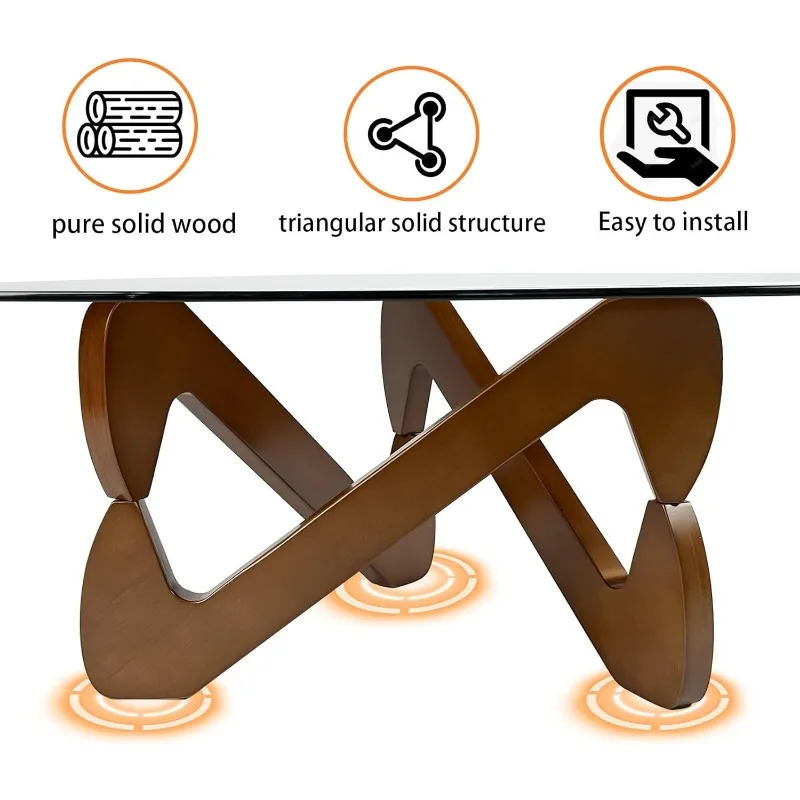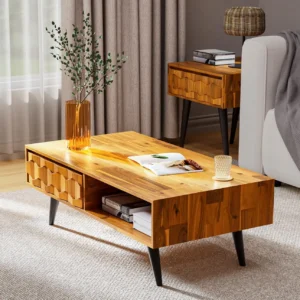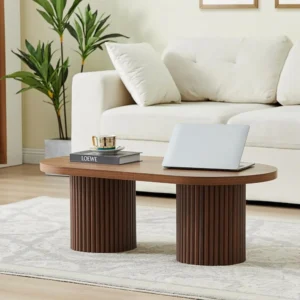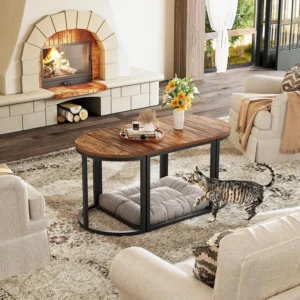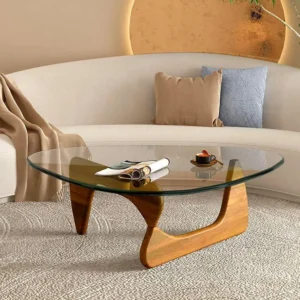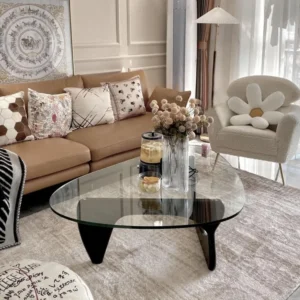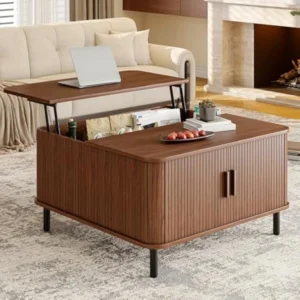Introduction to Scandinavian and Danish Design
When exploring modern interior design, few elements make as significant a statement as a well-chosen coffee table. At the heart of many stylish living spaces lies either a Scandinavian or Danish coffee table design—two styles that share common roots but display distinct characteristics that set them apart.
Scandinavian design encompasses furniture styles from across the Nordic countries—Norway, Sweden, Finland, Iceland, and Denmark. Danish design, meanwhile, represents a specific subset within this broader Scandinavian umbrella. While sharing fundamental principles, Danish design has evolved its own distinctive identity and approach to furniture creation.
These design traditions have profoundly influenced contemporary furniture worldwide, with their principles of functionality, simplicity, and quality craftsmanship resonating with modern sensibilities. For those looking to enhance their living spaces, understanding the nuances between Danish-inspired coffee table designs and their Scandinavian counterparts can help you select the perfect centerpiece that reflects your personal style.
As we explore these two closely related yet distinct design approaches, we’ll uncover the subtle differences that might inform your choice between them, from materials and forms to craftsmanship and overall aesthetic impact.
Core Principles of Scandinavian Design
Scandinavian design emerged from the Nordic countries of Norway, Sweden, Finland, Iceland, and Denmark, creating a cohesive design philosophy despite their geographical and cultural differences. This broad design movement embraces several foundational principles that define its distinctive character:
Minimalism and Simplicity: Scandinavian design favors clean lines and uncluttered spaces, removing unnecessary ornamentation in favor of pure functionality.
Democratic Design: There’s a strong emphasis on creating beautiful, functional objects accessible to everyone, not just the elite.
Connection to Nature: Natural materials, particularly light woods like pine, birch, and ash, feature prominently, reflecting the Nordic appreciation for the natural world.
Light and Brightness: Given the long, dark Nordic winters, Scandinavian design emphasizes light colors, reflective surfaces, and open spaces to maximize natural light.
“Lagom” Philosophy: This Swedish concept, meaning “just the right amount,” influences Scandinavian design through its focus on balance and moderation.
In Scandinavian interiors, you’ll typically find airy spaces with clean-lined furniture, light wood tones, and neutral color palettes accented with subtle touches of color. These spaces prioritize functionality without sacrificing beauty, creating environments that feel both practical and welcoming.
The definitive guide to Scandinavian coffee tables reveals how these pieces typically feature straightforward construction with minimal adornment. Many mid-century modern glass top coffee tables exemplify the Scandinavian focus on lightness and visual clarity, using transparent elements to create an airy feel within living spaces.
Core Principles of Danish Design
Danish design represents a refined subset within the broader Scandinavian design family, sharing its foundational principles while developing its own distinctive character. Though rooted in the same Nordic sensibilities, Danish furniture design has earned worldwide recognition for several defining characteristics:
Exceptional Craftsmanship: Danish design places extraordinary emphasis on quality construction and meticulous attention to detail, often showcasing the skill of the craftsperson.
Organic Forms: While still embracing simplicity, Danish design often incorporates softer, more sculptural shapes that respond to the human body and create visual interest.
“Hygge” Concept: This uniquely Danish notion of comfort and coziness influences furniture design, encouraging pieces that foster warmth and intimate social connection.
Premium Materials: Danish designers typically select higher-quality hardwoods like teak, rosewood, and oak with beautiful grain patterns that become focal elements of the design.
Timelessness Over Trends: Danish furniture is created to last generations, both structurally and aesthetically, prioritizing enduring design over momentary fashion.
Where Scandinavian design broadly emphasizes lightness and accessibility, Danish design often demonstrates a deeper commitment to material quality and sculptural refinement. The Danish coffee table construction craft traditions highlight this attention to detail, with techniques like finger joints and carefully shaped elements that reveal the hand of the maker.
The balance between form and function reaches its pinnacle in many mid-century modern Danish coffee tables, where beautiful objects serve practical purposes without compromise. These pieces demonstrate how Danish designers view furniture not merely as functional objects but as everyday art that enhances living spaces through thoughtful design and superior craftsmanship.
Distinguishing Features of Scandinavian Coffee Tables
Scandinavian coffee tables display several characteristic features that make them recognizable within the broader spectrum of modern furniture design:
Geometric Simplicity: These tables typically feature clean, straightforward shapes—rectangular, square, or simple round/oval forms—that embody minimalist principles.
Tapered Legs: A defining element of many Scandinavian tables is the slender, tapered leg that creates a light, floating appearance while providing sturdy support.
Light Wood Tones: Scandinavian coffee tables commonly utilize pale woods like birch, ash, or pine, often with clear finishes that highlight the natural color and grain patterns.
Multifunctionality: Many Scandinavian designs incorporate clever storage solutions—simple shelves or minimal compartments—reflecting the practical Nordic approach to living.
Clean Joinery: Construction methods typically aim for clean, unobtrusive joins that don’t distract from the overall form.
These tables generally project an airy, lightweight appearance that helps spaces feel more open and uncluttered. Their straightforward designs focus on essential elements, removing anything superfluous while maintaining visual balance and proportion.
The differences between Scandinavian vs midcentury modern design sometimes blur, but Scandinavian pieces typically lean toward lighter finishes and simpler forms. The popularity of mid-century modern rectangular coffee tables demonstrates how this geometric clarity continues to appeal to contemporary homeowners seeking clean, unfussy design.
Distinguishing Features of Danish Coffee Tables
Danish coffee tables stand apart from their broader Scandinavian counterparts through several distinctive characteristics that reflect Denmark’s unique design heritage:
Sculptural Quality: Danish tables often feature more organic, flowing forms with thoughtfully rounded edges and sculptural elements that invite touch.
Refined Proportions: These pieces typically demonstrate carefully considered proportions that create visual harmony while maintaining functional dimensions.
Rich Wood Selection: Danish designers favor beautiful hardwoods, particularly teak, walnut, and rosewood, often showcasing dramatic grain patterns as central design elements.
Sophisticated Joinery: Visible joinery in Danish tables is often celebrated rather than hidden, with elegant dovetails and finger joints highlighting craftsmanship.
Warmth and Character: While still minimalist, Danish tables typically convey greater warmth through deeper wood tones and more nuanced shaping.
Danish coffee tables often become statement pieces that anchor living spaces through their compelling forms and visual richness. The attention to detail extends to every element—from precisely shaped legs to carefully considered tabletop edges—creating pieces with both visual and tactile appeal.

The Danish modern coffee table elements typically include more refined details and expressive shaping than seen in broader Scandinavian design. This approach is particularly evident in many mid-century modern walnut coffee tables, where the rich, warm tones of the wood complement the sophisticated forms to create timeless pieces.
Materials and Craftsmanship Comparison
The materials and construction methods used in Scandinavian and Danish coffee tables represent one of the clearest distinctions between these related styles:
| Aspect | Scandinavian Approach | Danish Approach |
|---|---|---|
| Primary Woods | Pine, birch, ash, beech | Teak, rosewood, walnut, oak |
| Wood Character | Light, subtle grain | Rich, prominent grain patterns |
| Secondary Materials | Laminate, glass, painted surfaces | Primarily solid hardwoods, some leather, brass |
| Joinery | Simple, functional joints | Complex, precise joinery as design feature |
| Finishing | Light, clear finishes, sometimes paint | Oil finishes emphasizing natural wood color |
| Construction Focus | Efficient, democratic production | Meticulous craftsmanship |
Scandinavian furniture broadly embraces lighter woods and simpler construction methods that align with its democratic design philosophy. These pieces often feature straightforward joinery that prioritizes structural integrity over decorative impact, making them well-suited for efficient production while maintaining quality.
Danish furniture, in contrast, elevates craftsmanship to an art form. The selection of premium hardwoods isn’t merely aesthetic—these denser materials allow for more refined shaping and joinery techniques that wouldn’t be possible with softer woods. The hardwood vs softwood coffee tables comparison reveals how material choice fundamentally shapes both the design possibilities and the finished character of these pieces.
At Hearth Forms, our mid-century modern solid wood coffee tables reflect this appreciation for quality materials and thoughtful construction. Each piece demonstrates how proper material selection and craftsmanship create furniture that remains beautiful and functional for generations.
Visual Elements: Forms and Shapes Analysis
The shapes and forms used in Scandinavian and Danish coffee tables reveal fundamental differences in design philosophy and aesthetic approach:
Scandinavian coffee tables generally favor geometric clarity—rectangular, square, or simple circular forms with minimal elaboration. These straightforward shapes create clean silhouettes that integrate easily into various interior styles. The tabletops typically feature thin profiles with minimal edge detailing, contributing to their light, floating quality.
Danish coffee tables, while still embracing simplicity, often incorporate more organic and fluid shapes. Kidney-shaped, oval, or free-form tabletops with softly rounded corners are common in Danish design. These more sculptural forms create visual interest while maintaining functional surfaces. The edges of Danish tabletops frequently receive special attention, with gentle beveling or subtle shaping that creates appealing visual and tactile qualities.
Leg design provides another telling contrast. Scandinavian tables typically feature straight or gently tapered legs with minimal shaping. Danish tables, however, often showcase more expressive leg designs with careful sculpting, splayed positioning, or distinctive joinery where they meet the tabletop.
These different approaches to form significantly impact how each style influences a room’s overall feel. Scandinavian pieces tend to recede visually, creating a sense of openness and simplicity. Danish pieces, with their more assertive forms, often become focal points that anchor the space while expressing the designer’s artistic vision.
When identifying Danish-inspired coffee tables, these distinctive shaping elements provide important clues that help distinguish authentic Danish design from broader Scandinavian or imitative pieces.
The Role of Color and Finish
The color palette and finishing techniques employed in Scandinavian and Danish coffee tables create distinctly different visual and tactile experiences:
Scandinavian finishes typically aim to preserve or enhance the natural lightness of their wood selections. Clear lacquers that protect while maintaining the pale character of birch, pine, or ash are common. Some Scandinavian pieces incorporate painted elements—usually in white, soft pastels, or cool neutrals—to further brighten spaces and create visual contrast.
Danish finishes, by contrast, typically celebrate the natural warmth and depth of their hardwood materials. Oil-based finishes that penetrate the wood rather than creating a surface film are traditional in Danish furniture making. These oils enhance the wood’s natural color while providing a subtle sheen that deepens over time. The tactile quality of an oil-finished Danish coffee table—smooth yet warm to the touch—creates a sensory experience that many furniture enthusiasts prize.
The interaction with light also differs significantly between these finishing approaches. Scandinavian pieces with their lighter, sometimes matte finishes tend to reflect light softly and evenly, brightening spaces. Danish pieces with oil-finished hardwoods typically absorb and refract light in more complex ways, creating subtle highlights and shadows that showcase the wood’s natural grain patterns and color variations.
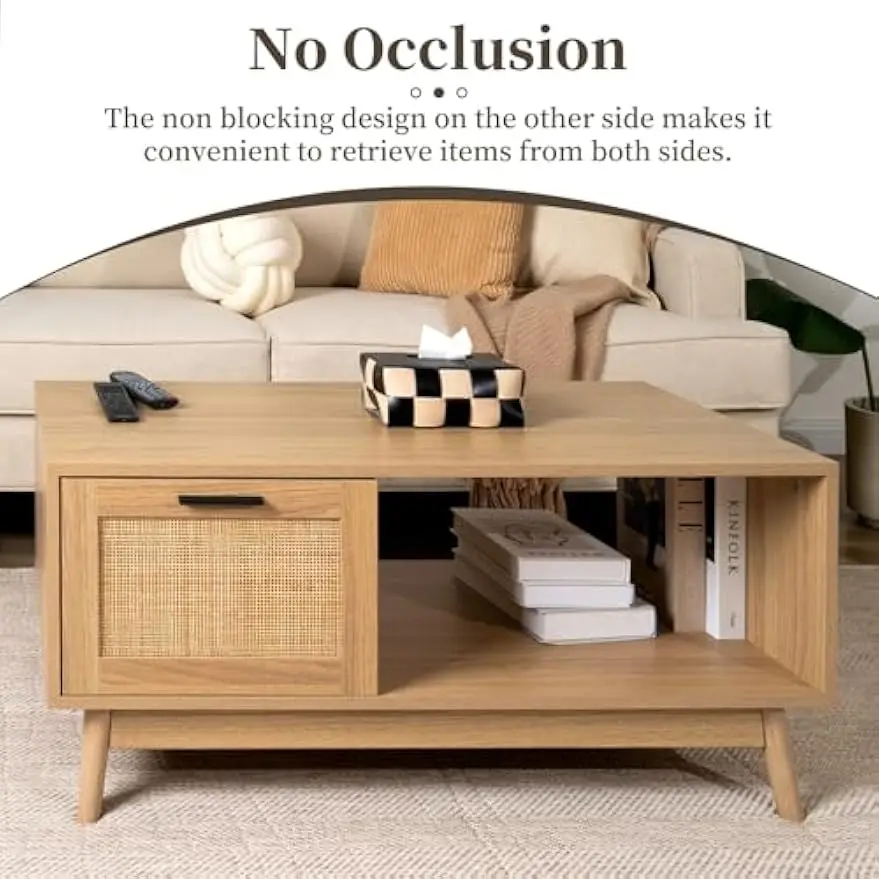
These finish choices profoundly influence how each style establishes its identity within interior spaces. The Danish coffee table design guide often emphasizes how these warm, natural finishes contribute to the intimate, welcoming character that makes Danish furniture so enduringly appealing.
How to Identify Authentic Styles
For those interested in acquiring genuine Scandinavian or Danish coffee tables—whether vintage or contemporary—recognizing authentic design characteristics is essential:
Authentic Scandinavian Coffee Table Indicators:
* Clean, geometric forms without unnecessary ornamentation
* Light-colored woods like birch, pine, or ash
* Simple, tapered legs with minimal detailing
* Thin profiles and visually lightweight appearance
* Clear finishes that maintain wood’s natural light color
* Straightforward, practical construction methods
Authentic Danish Coffee Table Indicators:
* More organic forms with thoughtful shaping and curves
* Premium hardwoods, particularly teak, rosewood, or walnut
* Carefully sculpted elements, especially legs and edges
* Exceptional joinery with precise fit and alignment
* Oil finishes that enhance wood’s natural depth
* Evidence of hand craftsmanship in details
Beyond these visual cues, examining construction quality provides further authentication. Genuine Danish pieces typically feature solid hardwood construction throughout—even in less visible areas—with consistent material quality. The underside of an authentic Danish table often reveals the same careful workmanship as its visible surfaces.
Proportional harmony represents another key indicator. The key characteristics of Danish coffee tables include thoughtfully balanced dimensions that create visual harmony while ensuring practical function. This careful proportioning—neither too heavy nor too insubstantial—reflects the designer’s understanding of both aesthetic principles and human needs.
Choosing the Right Style for Your Home
Selecting between Scandinavian and Danish coffee table designs depends on both your practical needs and your aesthetic preferences:
Consider Scandinavian coffee tables when:
* You prefer lighter, airier spaces with visual simplicity
* Your existing furniture features clean lines and lighter finishes
* You want to create a sense of openness in smaller rooms
* Your lifestyle favors practical, unfussy solutions
* You appreciate subtle, understated design elements
Consider Danish coffee tables when:
* You value exceptional craftsmanship and material quality
* Your space would benefit from a distinctive focal point
* Your existing furniture incorporates warm wood tones
* You appreciate organic forms and tactile qualities
* You view furniture as an investment in timeless design
These styles can also complement different interior approaches. Scandinavian coffee tables naturally enhance minimalist, contemporary, or casual interiors. Danish pieces work beautifully in mid-century modern settings but also create compelling contrasts in contemporary spaces or sophisticated traditional rooms.
Scale represents another important consideration. Scandinavian pieces, with their lighter visual weight, often work well in smaller spaces without overwhelming them. Danish pieces, while still relatively compact compared to many furniture traditions, often have a more substantial presence that anchors larger seating arrangements effectively.
Explore our mid-century modern coffee tables collection to find pieces that reflect both traditions, allowing you to select the perfect balance of form, function, and craftsmanship for your home.
Mid-Century Modern Solid Wood Coffee Tables, Mid-Century Modern Teak Coffee Tables
$879.95 Select options This product has multiple variants. The options may be chosen on the product pageMid-Century Modern Danish Coffee Tables, Mid-Century Modern Oval Coffee Tables, Mid-Century Modern Solid Wood Coffee Tables
$390.05 Select options This product has multiple variants. The options may be chosen on the product pageMid-Century Modern Coffee & End Table Sets, Mid-Century Modern Coffee Table Sets, Mid-Century Modern Oval Coffee Tables
Price range: $257.48 through $331.04 Select options This product has multiple variants. The options may be chosen on the product pageMid-Century Modern Glass Top Coffee Tables, Mid-Century Modern Glass Top Side & End Tables
$460.58 Select options This product has multiple variants. The options may be chosen on the product pageMid-Century Modern Glass Top Coffee Tables, Mid-Century Modern Vintage Coffee Tables, Mid-Century Modern Vintage Side & End Tables
$725.36 Select options This product has multiple variants. The options may be chosen on the product pageMid-Century Modern Lift Top Coffee Tables, Mid-Century Modern Square Coffee Tables
$454.73 Select options This product has multiple variants. The options may be chosen on the product page
How These Styles Have Evolved in Modern Design
While rooted in mid-20th century design movements, both Scandinavian and Danish coffee table aesthetics continue to evolve in contemporary furniture design:
Modern interpretations of Scandinavian coffee tables often incorporate new materials alongside traditional elements. Today’s designs might combine the classic tapered leg with glass tops or integrate subtle technological features while maintaining the clean, minimalist aesthetic that defines the style. Contemporary Scandinavian pieces frequently feature increased sustainability considerations, with emphasis on environmentally responsible materials and production methods.
Danish design evolution tends to maintain stronger connections to traditional craftsmanship while thoughtfully incorporating contemporary elements. Modern Danish-inspired pieces often preserve the organic forms and material quality of classic designs while adapting to contemporary living needs. Some incorporate height-adjustable features or modular elements that respond to today’s flexible living arrangements.

Both traditions have influenced broader furniture design, with their principles of honest materials, functional beauty, and human-centered design now appearing across many contemporary styles. The enduring appeal of these approaches speaks to how successfully they balance practical needs with aesthetic satisfaction—a combination that remains relevant regardless of changing fashion.
The modern Danish coffee table design approach demonstrates how traditional principles can adapt to contemporary contexts without losing their essential character. These evolving interpretations ensure that both Scandinavian and Danish design traditions remain vital influences in today’s furniture landscape.
What Makes Danish Coffee Tables Worth the Investment?
Danish coffee tables often command premium prices compared to other styles, reflecting several factors that contribute to their lasting value:
Exceptional Craftsmanship: The time-intensive construction methods and meticulous attention to detail result in pieces that maintain their structural integrity for generations.
Premium Materials: The use of high-quality hardwoods like teak, rosewood, and walnut ensures durability while developing richer patina over time.
Design Integrity: Danish coffee tables represent holistic design thinking, with every element—from overall form to the smallest joint—thoughtfully considered.
Timeless Aesthetic: These pieces transcend trends, remaining visually relevant and appealing regardless of changing fashion.
The investment quality of Danish coffee tables becomes apparent over time as they maintain both their function and beauty while less carefully crafted pieces deteriorate. Many vintage Danish coffee tables have appreciated significantly in value, particularly those by recognized designers whose work embodies the Danish coffee tables minimalist design principles while expressing unique creative vision.
Are Scandinavian Coffee Tables Better for Smaller Spaces?
Scandinavian coffee table designs often prove particularly well-suited to compact living environments for several reasons. Their characteristically light visual weight—created through slender proportions, pale woods, and simple forms—helps prevent smaller rooms from feeling cramped or overwhelmed. Many Scandinavian designs also incorporate practical storage solutions that maximize functionality without increasing bulk.
The clean, uncluttered aesthetic of Scandinavian coffee tables contributes to a sense of openness that benefits limited spaces. By avoiding heavy ornamentation or visually dominant features, these pieces maintain visual calm while providing necessary function.
However, smaller-scale Danish coffee tables can work equally well in compact settings, particularly when their organic forms help soften the sometimes boxy confines of apartment living. For truly space-constrained situations, our mid-century modern small coffee tables collection offers carefully proportioned options in both design traditions.
How Do These Designs Complement Different Interior Styles?
Both Scandinavian and Danish coffee table designs demonstrate remarkable versatility across various interior styles, though each creates distinctive effects:
Scandinavian coffee tables integrate seamlessly into contemporary minimalist interiors, where their clean lines and light presence enhance the overall sense of simplicity. They also work surprisingly well in traditional settings, where their understated character provides a refreshing counterpoint to more ornate elements without creating jarring contrast.
Danish coffee tables make natural companions to mid-century modern interiors, complementing furniture from the same design tradition with harmonious forms and materials. They also create compelling focal points in contemporary spaces, where their organic shapes and rich materials add warmth and visual interest to more austere surroundings.
Both styles can enhance eclectic interiors, though in different ways. Scandinavian pieces often provide visual “breathing room” amidst more diverse elements, while Danish pieces contribute sophisticated craftsmanship and material quality that elevates the overall collection.
Understanding the key features of Scandinavian furniture helps in creating cohesive interiors that balance these design traditions effectively, whether you’re fully embracing Nordic minimalism or thoughtfully incorporating selected elements into a more eclectic approach.

